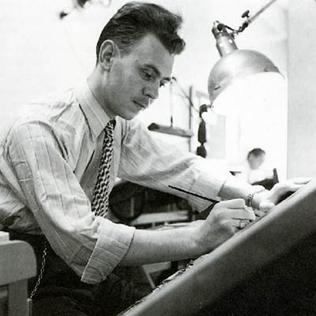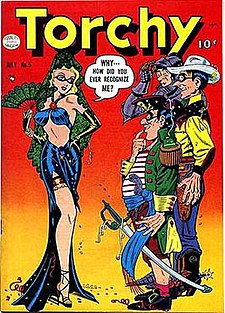
Sheena, Queen of the Jungle, is a fictional American comic book jungle girl heroine, originally published primarily by Fiction House during the Golden Age of Comic Books. She was the first female comic book character with her own title, with her 1941 premiere issue preceding Wonder Woman #1. Sheena inspired a wealth of similar comic book jungle queens. She was predated in literature by Rima, the Jungle Girl, introduced in the 1904 William Henry Hudson novel Green Mansions.

Cherry is an erotic comic book about a sexually adventurous 18-year-old woman and her friends, written and drawn by Larry Welz.

Comics Revue is a bi-monthly small press comic book published by Manuscript Press and edited by Rick Norwood. Don Markstein edited the publication from 1984 to 1987 and 1992 to 1996.

Mort Todd is an American writer and media entrepreneur, best known as an editor-in-chief of Cracked magazine, and later, Marvel Music. He is owner of Comicfix, a media company that has developed licensed properties.

Jane Arden was an internationally syndicated daily newspaper comic strip which ran from November 26, 1928 to January 20, 1968. The title character was the original "spunky girl reporter", actively seeking to infiltrate and expose criminal activity rather than just report on its consequences and served as a prototype for later characters such as Superman supporting character Lois Lane and fellow comic strip heroine Brenda Starr, Reporter. Pulitzer Prize-winning columnist Mary McGrory credited Jane Arden with instilling her interest in journalism.
United Feature Syndicate, Inc. (UFS) is a large American editorial column and comic strip newspaper syndication service based in the United States and established in 1919. Originally part of E. W. Scripps Company, it was part of United Media from 1978 to 2011, and is now a division of Andrews McMeel Syndication. United Features has syndicated many notable comic strips, including Peanuts, Garfield, Li'l Abner, Dilbert, Nancy, and Marmaduke.

Rip Kirby is an American comic strip created by Alex Raymond and Ward Greene featuring the adventures of private detective Rip Kirby. The strip ran from 1946 to 1999 and was in the hands of artist John Prentice for more than 40 years.

Secret Agent X-9 is a comic strip created by writer Dashiell Hammett and artist Alex Raymond. Syndicated by King Features, it ran from January 22, 1934 until February 10, 1996.

Jungle Jim is the fictional hero of a series of jungle adventures in various media. The series began on January 7, 1934, as an American newspaper comic strip chronicling the adventures of Asia-based hunter Jim Bradley, who was nicknamed Jungle Jim. The character also trekked through radio, film, comic book and television adaptations. Notable was a series of films and television episodes in which Johnny Weissmuller portrayed the safari-suit wearing character, after hanging up his Tarzan loincloth. The strip concluded on August 8, 1954.

Lady Luck is an American comic-strip and comic-book crime fighter and adventuress created and designed in 1940 by Will Eisner with artist Chuck Mazoujian. She starred in a namesake, four-page weekly feature published in a Sunday newspaper comics insert colloquially called "The Spirit Section", which ran from June 2, 1940, to November 3, 1946. Her adventures were reprinted in comic books published by Quality Comics. A revamped version of the character debuted in 2013 in DC Comics's Phantom Stranger comic.

Katy Keene is a character created by Bill Woggon that has appeared in several comic book series published by Archie Comics since 1945. She is a model/actress/singer marketed by the publisher as "America's Queen of Pin-Ups and Fashions". In the book From Girls to Grrrlz: A History of Women's Comics from Teens to Zines by Trina Robbins, Katy Keene is called a Bettie Page look-alike. "... but the resemblance ended there.
Revolutionary Comics was an American comic book publisher specializing in unauthorized profiles of entertainers and professional athletes, as well as a line of erotic comics. Its flagship series was Rock 'N' Roll Comics. Founded by Todd Loren, Revolutionary Comics was based in San Diego.

James Winslow "Win" Mortimer was a Canadian comic book and comic strip artist best known as one of the major illustrators of the DC Comics superhero Superman. He additionally drew for Marvel Comics, Gold Key Comics, and other publishers.

Rulah, Jungle Goddess is a fictional character, a jungle girl, in comic books published by Fox Feature Syndicate. She first appeared in Zoot Comics #7. Matt Baker designed her, before Jack Kamen and Graham Ingels helped develop her image.

William Hess Ward, was an American cartoonist notable as a good girl artist and creator of the risqué comics character Torchy.

Tarzan, a fictional character created by Edgar Rice Burroughs, first appeared in the 1912 novel Tarzan of the Apes, and then in 23 sequels. The character proved immensely popular and quickly made the jump to other media, including comics.

Good Girl Art (GGA) is a style of artwork depicting women primarily featured in comic books, comic strips, and pulp magazines. The term was coined by the American Comic Book Company, appearing in its mail order catalogs from the 1930s to the 1970s, and is used by modern comic experts to describe the hyper-sexualized version of femininity depicted in comics of the era.
The Bell Syndicate, launched in 1916 by editor-publisher John Neville Wheeler, was an American syndicate that distributed columns, fiction, feature articles and comic strips to newspapers for decades. It was located in New York City at 247 West 43rd Street and later at 229 West 43rd Street. It also reprinted comic strips in book form.
Uncle Remus and His Tales of Br'er Rabbit is an American Disney comic strip that ran on Sundays from October 14, 1945, to December 31, 1972. It first appeared as a topper strip for the Mickey Mouse Sunday page, but after the first few years, almost always appeared on its own. The strip replaced the 1932-1945 Silly Symphony strip, which had spent its final year on gag strips featuring Panchito from The Three Caballeros.

Alan L. Light is a publisher involved in comics and pop culture fandom. He is best known as the founder of The Buyer's Guide for Comic Fandom, which was the longest-running English-language periodical reporting on the American comic book industry.
















